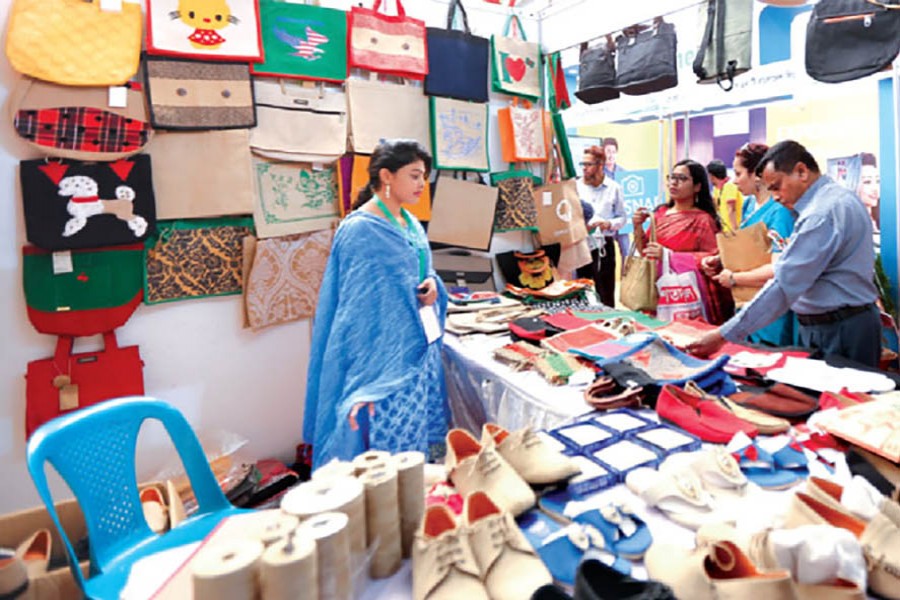Dhaka
Untapped potential of cottage industries in Bangladesh

Md Al Noman
July 27th, 2024 | 11:22:35 AMIN THE intricate tapestry of Bangladesh’s economy, cottage industries stand as a testament to the artistry and resilience of its people. These industries, rooted in local raw materials and inherited skills, have a unique ability to infuse products with the personal touch of their creators. Unlike large-scale factories, cottage industries thrive on the artisan’s ability to shape beauty and individuality into their creations.
Cottage industries, often family-based or small enterprises, embody simplicity and local expertise. They operate in both rural and urban settings, utilising minimal capital to produce cost-effective goods. The Bangladesh Small and Cottage Industries Corporation, a state-owned enterprise, has been established for the development and supervision of small and cottage industries in Bangladesh. Symphony of craftsmanship AT THE heart of cottage industries lies a distinctiveness that sets them apart from the impersonal churn of machinery in larger factories. These enterprises weave products with the threads of inherited skills, transforming local raw materials into unique, artisanal creations. The artisan’s touch becomes a signature, imprinting individuality and charm on each piece. Distinctive features define cottage industries, including their low capital requirements, home-based production, and the artistic imprint evident in each product. One of the characteristics of the cottage industry is that it reflects an impression of artistic talent. Craft can bring variety to the product. Moreover, the artist’s handmade products are beautiful to look at and last longer. In a developing nation like Bangladesh, the artistic importance of cottage industries cannot be overstated. These industries hold the potential to drive economic progress by offering unique products that can compete on the global stage. Japan’s success with cottage industries serves as a beacon, demonstrating the transformative power of these enterprises in propelling a country towards prosperity. According to a survey by the Small and Cottage Industries Association of Bangladesh, there are over 800,000 cottage industries in Bangladesh that can be divided into eight categories. If Bangladesh can further expand its cottage industries, transforming them into a consumer goods industry, the nation can rise as an economic powerhouse in Asia. Once, the industry was a marvel, with villages thriving as self-sufficient hubs of creativity. Weavers, potters, and craftsmen produced a myriad of goods, including the renowned Bengal muslin. However, the mighty wave of the Industrial Revolution, led by European nations, swept away the once-vibrant cottage industry, leaving behind memories of a bygone era. Current challenges and contributions IN THE present landscape, cottage industries face challenges from large-scale factories and changing consumer preferences. Despite this, they persist, contributing significantly to the country’s GDP. As of June 2017, there were 8.48 lakh cottage industries engaging 37.53 lakh workers, showcasing a growth rate of 9.21 per cent. The ever-evolving preferences of consumers, coupled with the efficiency of large-scale factories, pose formidable challenges. However, the resilience of cottage industries is evident in their continued contribution to the nation’s GDP and the employment of a significant labour force. Future of cottage industry BANGLADESH’S cottage industry has a bright future. As the country is going to graduate from being a least developed country soon and is now grappling with high inflationary pressure, Bangladesh urgently needs to diversify its exports and export markets to stabilise its economy. We need to emphasise cottage industries to create employment in rural areas and economic prosperity. This will also create a circle of opportunities for many as the raw materials for the industry are being produced domestically, and the low production cost and labour availability lessen the economic risk in the industry. However, it should be kept in mind that the long-standing problems of the cottage industry have to be overcome through a deliberate and constructive process. Ways to revive cottage industries CONSIDERING the potential positive impact of the cottage industry on the economy, various steps need to be implemented at the government and private levels to provide the necessary excellence of the cottage industry. The Bangladesh Small and Cottage Industries Corporation also has to take essential steps in the areas of training of artisans, improvement of production processes, market management, capital supply, etc. In a poor country like Bangladesh, the need for cottage industries is immense. The cottage industry has the right to exist next to large-scale industries for its own sake. Just as handicraft products can meet the needs of the people, the country can become self-reliant by reducing the import of foreign goods. Moreover, the expansion of cottage industries will generate employment opportunities in both rural and urban areas. To mention, about 60 per cent of Japan’s exports come from cottage industries, and 30 per cent of the country’s labour force is engaged in small-scale industries. In developed countries, cottage industries are proudly competing with large-scale industries. The traders of those countries are preparing a lot of products by installing small industrial machines and exporting them abroad after meeting their own needs. The road ahead holds immense promise for cottage industries in Bangladesh. As the nation strives for economic stability, the revival of cottage industries emerges as a beacon of hope. With the potential to utilise local resources and create goods tailored for both domestic and international markets, cottage industries can play a pivotal role in steering Bangladesh towards prosperity. Md Al Noman is a deputy junior officer at Pubali Bank PLC.
No comments yet!!!
